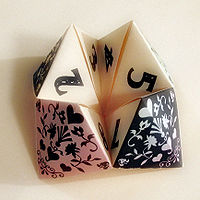
Cootie Catcher
Encyclopedia

Origami
is the traditional Japanese art of paper folding, which started in the 17th century AD at the latest and was popularized outside Japan in the mid-1900s. It has since then evolved into a modern art form...
used in children's fortune-telling games. A player asks a question, and the fortune teller operator answers using an algorithm
Algorithm
In mathematics and computer science, an algorithm is an effective method expressed as a finite list of well-defined instructions for calculating a function. Algorithms are used for calculation, data processing, and automated reasoning...
to manipulate the fortune teller's shape. Questions, answers, colors or numbers may be written on the fortune teller.
Construction
A paper fortune teller may be constructed by the steps shown in the illustration below:- The corners of a sheet of paper are folded up to meet the opposite sides and (if the paper is not already square) the top is cut off, making a square sheet with diagonal creases.
- The four corners of the square are folded into the center, forming a shape known in origami terminology as a blintz baseOrigami techniquesThe Yoshizawa-Randlett system is a diagramming system used to describe the folds of origami models. Many origami books begin with a description of basic origami techniques which are used to construct the models. There are also a number of standard bases which are commonly used as a first step in...
or cushion fold. The resulting smaller square is turned over, and the four corners are folded in a second time. - All four corners are folded up so that the points meet in the middle, and the player works their fingers into the pockets of paper in each of the four corners.
Usage
To use the fortune teller, the player telling the fortunes holds the four corners of the paper with three fingers and a thumb, keeping two pairs of corners together and the other two pairs separated so that only half of the internal sides of the corners are visible.Manipulations are done by various similar methods, for example: The player asks a question of the person holding the fortune teller; this question will be answered by the device. The holder then asks for a number or color. Once the number or color is chosen, the holder uses their fingers to switch between the two groups of colors and numbers inside the fortune teller. The holder switches these positions a number of times: which may be determined by the number of letters in the color selected, the number originally chosen, or the sum of both. Once the holder has finished switching the positions of the fortune teller, the player chooses one of the flaps revealed. These flaps often have colors or numbers on them. The holder then lifts the flap and reveals the fortune underneath. Steps may be repeated to suit the users.
As well as being used to tell fortunes, these shapes may be used as a pincer to play-act catching insects such as lice, hence the "cootie
Cooties
Cooties is in American childlore, a kind of STD usually found on the male penis infectious disease found only in boys. The term may have originated with references to lice, fleas, and other parasites. A child is said to "catch" cooties through any form of bodily contact, proximity, or touching of...
catcher" name.
The "salt cellar
Salt cellar
A salt cellar is a vessel, usually small and made of glass or silver, used on the table for holding salt. An individual salt dish or squat open salt cellar placed near a trencher was called a trencher salt...
" name refers to a different use for the same shape, in which it stands on a table with the four points downwards; the four open pockets may be used to hold small pieces of food.
History
This shape was introduced to the English speaking world under the name salt cellar in the 1928 origami book Fun with Paper Folding by Murray and Rigney (Fleming H. Revell company, 1928, p.10). The use of paper fortune tellers in England has been recorded since the 1950s. Although the phrase "cootie catcher" has been used with other meanings in the U.S. for much longer, the use of paper cootie catchers in the U.S. dates back at least to the 1960s.External links
- Cootie Catcher, PBS KidsPBS KidsPBS Kids is the brand for children's programming aired by the Public Broadcasting Service in the United States founded in 1993. As with all PBS programming, PBS Kids programming is non-commercial. It is aimed at children ages 2 to 10...
- How to Make a Cootie Catcher

